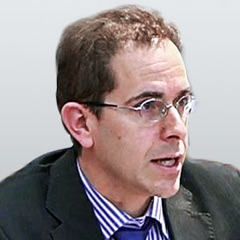A iceberg floats in the sea near Qeqertarsuaq, Disko Island, Greenland, on July 21, 2011.
(AP Photo/Brennan Linsley)
(AP Photo/Brennan Linsley)
Political and corporate leaders gathered for the climate week in New York City have urged significant action to fight global warming. But, given the high costs of the suggested solutions, could it be that the suggested cure is worse than the disease?
As a liberal who grew up in a solar house, I have always been energy-conscious and inclined toward activist solutions to environmental issues. I was therefore extremely surprised when my research as an astrophysicist led me to the conclusion that climate change is more complicated than we are led to believe. The disease is much more benign, and a simple palliative solution lies in front of our eyes.
To begin with, the story we hear in the media, that most 20th-century warming is anthropogenic, that the climate is very sensitive to changes in CO2, and that future warming will, therefore, be large and will happen very soon, simply isn’t supported by any direct evidence, only a shaky line of circular reasoning. We “know” that humans must have caused some warming, we see warming, we don’t know of anything else that could have caused the warming, so it adds up.
However, there is no calculation based on first principles that leads to a large warming by CO2—none. Mind you, the Intergovernmental Panel on Climate Change (IPCC) reports state that doubling CO2 will increase the temperatures by anywhere from 1.5 degrees to 4.5 degrees C, a huge range of uncertainty that dates back to the Charney committee from 1979.
In fact, there is no evidence on any time scale showing that CO2 variations or other changes to the energy budget cause large temperature variations. There is, however, evidence to the contrary. Tenfold variations in CO2 over the past half-billion years have no correlation whatsoever with temperature; likewise, the climate response to large volcanic eruptions such as Krakatoa.
Both examples lead to the inescapable upper limit of 1.5 degrees C per CO2 doubling—much more modest than the sensitive IPCC climate models predict. However, the large sensitivity of the latter is required in order to explain 20th-century warming, or so it is erroneously thought.
In 2008, I showed, using various data sets that span as much as a century, that the amount of heat going into the oceans, in sync with the 11-year solar cycle, is an order of magnitude larger than the relatively small effect expected simply from changes in the total solar output. Namely, solar activity variations translate into large changes in the so-called radiative forcing on the climate.
In the decade following the publication of the above, not only was the paper uncontested, more data, this time from satellites, confirmed the large variations associated with solar activity. In light of this hard data, it should be evident by now that a large part of the warming isn’t human, and that future warming from any given emission scenario will be much smaller.
Alas, because the climate community developed a blind spot to any evidence that should raise a red flag, such as the aforementioned examples or the much smaller tropospheric warming over the past two decades than models predicted, the rest of the public sees a very distorted view of climate change—a shaky scientific picture that is full of inconsistencies became one of certain calamity.
With this public mindset, phenomena such as that of child activist Greta Thunberg are no surprise. Most bothersome, however, is that this mindset has compromised the ability to convey the science to the public.
One example from the past month is my interview with Forbes. A few hours after the article was posted online, it was removed by the editors “for failing to meet our editorial standards.” The fact that it’s become politically incorrect to have any scientific discussion has led the public to accept the pseudo-argumentation supporting the catastrophic scenarios.
Evidence for warming doesn’t tell us what caused the warming, and any time someone has to appeal to the so-called 97 percent consensus, he or she is doing so because his or her scientific arguments aren’t strong enough. Science isn’t a democracy.
Whether the Western world will overcome this ongoing hysteria in the near future, it’s clear that on a time scale of a decade or two, it would be a thing of the past. Not only will there be growing inconsistencies between model and data, a much-stronger force will change the rules of the game.
Once China realizes it can’t rely on coal anymore, it will start investing heavily in nuclear power to supply its remarkably increasing energy needs, at which point, the West won’t fall behind. We will then have cheap and clean energy-producing carbon-neutral fuel, and even cheap fertilizers that will make the recently troubling slash-and-burn agriculture redundant.
The West would then realize that global warming never was and never will be a serious problem. In the meantime, the extra CO2 in the atmosphere would even increase agriculture yields, as it has been found to do in arid regions in particular. It is plant food after all.
Professor Nir Shaviv @nshaviv is the chairman of the Racah Institute of Physics at the Hebrew University of Jerusalem.
Views expressed in this article are the opinions of the author and do not necessarily reflect the views of The Epoch Times.
https://www.theepochtimes.com/about-us


No comments:
Post a Comment